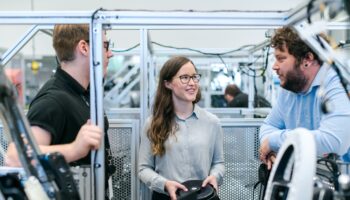Sports cars have always been synonymous with power, speed, and exhilaration. In Advance technology, the automotive industry is embracing automation to redefine the driving experience. From design and manufacturing to on-road performance, automation is revolutionizing the way new sports cars are developed and enjoyed. In this article, we explore how the automation industry is working to create the ultimate driving machines of the future.
- Design and Prototyping:
In the early stages of developing a new sports car, automation plays a crucial role in the design and prototyping. Computer-aided design (CAD) and simulation software allow designers to create intricate 3D models and test different configurations virtually. It accelerates the design cycle, allowing engineers to refine the car’s aerodynamics, performance, and aesthetics precision.
With the help of automated prototyping techniques like 3D printing, physical models can be rapidly produced and assessed, enabling designers to validate their concepts before moving to full-scale production. This iterative design process ensures that every sports car is well-optimized for maximum performance and efficiency.
- Manufacturing and Assembly:
Automation in manufacturing is a game-changer for sports car production. Robotics and advanced manufacturing technologies are used to streamline the assembly line, reducing human error and enhancing efficiency. Robots can perform tasks like welding, painting, and precision assembly with unmatched accuracy and consistency, ensuring each sports car meets the highest quality standards.
Additionally, factories equipped with the Internet of Things (IoT) technology can monitor production processes in real-time, optimizing workflows and identifying potential issues before they escalate. This level of automation allows sports car manufacturers to deliver high-quality vehicles faster, meeting the demands of performance-hungry enthusiasts worldwide.
- Advanced Driver Assistance Systems (ADAS):
Automation in sports cars is not limited to the manufacturing process; it extends to on-road performance. Advanced Driver Assistance Systems (ADAS) linked with sensors, cameras, and AI algorithms enhance safety and performance. Features like adaptive cruise control, lane-keeping assistance, and collision avoidance help drivers stay in control while pushing the limits of their sports cars.
Furthermore, automation enables connected car technologies, allowing sports cars to communicate with other vehicles and infrastructure. It facilitates real-time data exchange, optimizing route ideas, and enhancing the driving experience.
- Autonomous Sports Cars:
According to the future, automation holds the potential to introduce fully autonomous sports cars. Enthusiasts may argue that the thrill of driving comes from the human touch, but autonomous driving is integrated into sports cars to provide a more immersive experience. Drivers could switch between manual and autonomous modes, allowing them to enjoy the thrill of high-performance driving on a racetrack and then let the car take over during daily commuting.
- Data-Driven Performance Optimization:
Automation and data analytics go hand in hand in the automotive industry. Advanced sensors and telemetry systems in sports cars collect real-time data on performance metrics like speed, acceleration, and handling. This data is then analyzed using machine learning algorithms to optimize the car’s performance and responsiveness.
Race teams can also leverage automation to fine-tune sports cars for specific tracks and driving conditions. By processing vast amounts of data, engineers can make precise adjustments to maximize the car’s performance, giving drivers a competitive edge on the track.
Conclusion
The automation industry is transforming sports cars from all angles, from design and manufacturing to on-road performance and data analysis. Through automation, sports car enthusiasts can experience cutting-edge design, high-speed precision manufacturing, advanced driver assistance systems, and even the possibility of autonomous driving. As the technology continues to evolve, sports cars will become faster, safer, and more exhilarating than ever, setting new benchmarks for the automotive world and pushing the boundaries of high-performance driving.
- THE EVOLUTION OF PLASTIC SURGERY - 17 June 2024
- CHOOSE THE RIGHT PERSONAL INJURY LAW FIRM IN CHARLOTTE NORTH CAROLINA - 16 June 2024
- Email UX optimization, offering actionable insights - 16 June 2024





